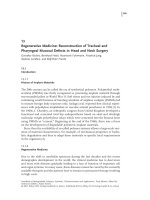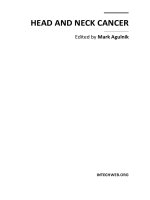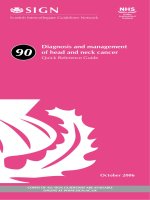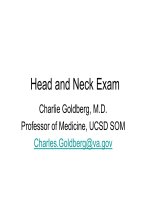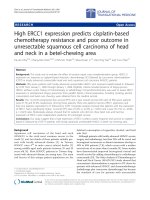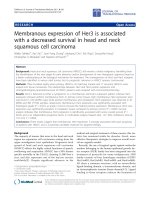Baileys head and neck surgery otolaryngology review (2014)
Bạn đang xem bản rút gọn của tài liệu. Xem và tải ngay bản đầy đủ của tài liệu tại đây (3.98 MB, 375 trang )
Bailey’s
Head & Neck Surgery—
OtOlaryNgOlOgy
REVIEW
DESIGN SERVICES OF
# 151645 Cust: Wolters Kluwer Health Au: Johnson Pg. No. ii
DESIGN SERVICES OF
Bailey’s
Head & Neck Surgery—
OtOlaryNgOlOgy
REVIEW
■ CLARK A. ROSEN, MD
Director, University of Pittsburgh Voice Center
Professor, Department of Otolaryngology
University of Pittsburgh Medical Center
Professor, Department of Communication Sciences Disorders
University of Pittsburgh
Pittsburgh, Pennsylvania
■ JONAS T. JOHNSON, MD
Chair, Department of Otolaryngology
Professor, Department of Otolaryngology and Radiation Oncology
University of Pittsburgh School of Medicine
Professor, Department of Oral and Maxofacial Surgery
University of Pittsburgh School of Dental Medicine
Pittsburgh, Pennsylvania
DESIGN SERVICES OF
Acquisitions Editor: Ryan Shaw
Product Manager: Nicole Dernoski
Production Product Manager: Bridgett Dougherty
Marketing Manager: Dan Dressler
Senior Manufacturing Manager: Beth Welsh
Design Manager: Steven Druding
Production Services: S4Carlisle Publishing Services
First Edition
© 2014 by Lippincott Williams & Wilkins, a Wolters Kluwer business
351 West Camden Street
Two Commerce Square
Baltimore, MD 21201
2001 Market Street
Philadelphia, PA 19103 USA
LWW.com
Printed in China
All rights reserved. This book is protected by copyright. No part of this book may be reproduced or transmitted in any form
or by any means, including as photocopies or scanned-in or other electronic copies, or utilized by any information storage
and retrieval system without written permission from the copyright owner, except for brief quotations embodied in critical
articles and reviews. Materials appearing in this book prepared by individuals as part of their official duties as U.S. government
employees are not covered by the above-mentioned copyright. To request permission, please contact Lippincott Williams &
Wilkins at Two Commerce Square, 2001 Market Street, Philadelphia, PA 19103, via email at , or via
website at lww.com (products and services).
Library of Congress Cataloging-in-Publication Data
ISBN 978-1-45119-253-7
Cataloging-in-Publication data available on request from the Publisher.
DISCLAIMER
Care has been taken to confirm the accuracy of the information present and to describe generally accepted practices. However,
the authors, editors, and publisher are not responsible for errors or omissions or for any consequences from application of
the information in this book and make no warranty, expressed or implied, with respect to the currency, completeness, or
accuracy of the contents of the publication. Application of this information in a particular situation remains the professional
responsibility of the practitioner; the clinical treatments described and recommended may not be considered absolute and
universal recommendations.
The authors, editors, and publisher have exerted every effort to ensure that drug selection and dosage set forth in this text
are in accordance with the current recommendations and practice at the time of publication. However, in view of ongoing
research, changes in government regulations, and the constant flow of information relating to drug therapy and drug reactions,
the reader is urged to check the package insert for each drug for any change in indications and dosage and for added warnings
and precautions. This is particularly important when the recommended agent is a new or infrequently employed drug.
Some drugs and medical devices presented in this publication have Food and Drug Administration (FDA) clearance for
limited use in restricted research settings. It is the responsibility of the health care provider to ascertain the FDA status of each
drug or device planned for use in their clinical practice.
To purchase additional copies of this book, call our customer service department at (800) 638-3030 or fax orders to (301) 2232320. International customers should call (301) 223-2300.
Visit Lippincott Williams & Wilkins on the Internet: . Lippincott Williams & Wilkins customer service
representatives are available from 8:30 am to 6:00 pm, EST.
10 9 8 7 6 5 4 3 2 1
# 151645 Cust: Wolters Kluwer Health Au: Johnson Pg. No. iv
DESIGN SERVICES OF
D E D I C AT I O N
I dedicate this book to the amazing group of authors and editors
of the Bailey’s Head & Neck Surgery—Otolaryngology textbook and to the authors
of the Bailey’s Head & Neck Surgery—Otolaryngology Review.
Your energy and zeal for excellence is inspiring.
In addition, I dedicate this book to my late mother, Shirley Maureen Orr Rosen,
who always encouraged me to be the best that I could be.
Her fortitude will live on in my heart.
Clark A. Rosen, MD
I dedicate this book to the patients who have taught me so much and to the next
generation of physicians who strive to serve them.
Jonas T. Johnson, MD
DESIGN SERVICES OF
AUTHORS
Basic Science/General Medicine
Laryngology
Shawn D. Newlands, MD, PhD, MBA, FACS
Professor and Chair
Department of Otolaryngology
University of Rochester Medical Center
Chief
Department of Otolaryngology
Strong Memorial Hospital
Rochester, New York
Milan R. Amin, MD
Associate Professor
Department of Otolaryngology—Head and Neck
Surgery
New York University School of Medicine
Associate Professor
Department of Otolaryngology—Head and Neck
Surgery
NYU Langone Medical Center
New York, New York
Karen T. Pitman, MD, FACS
Professor
Department of Otolaryngology
and Communicative Sciences
University of Mississippi Medical Center
Jackson, Mississippi
Rhinology and Allergy
Matthew W. Ryan, MD
Assistant Professor
Department of Otolaryngology
University of Texas Southwestern
Medical Center
Dallas, Texas
General Otolaryngology
Jonas T. Johnson, MD
Chair, Department of Otolaryngology
Professor, Department of Otolaryngology
and Radiation Oncology
University of Pittsburgh School of Medicine
Professor, Department of Oral and
Maxillofacial Surgery
University of Pittsburgh School of Dental
Medicine
Pittsburgh, Pennsylvania
Shawn D. Newlands, MD, PhD, MBA, FACS
Professor and Chair
Department of Otolaryngology
University of Rochester Medical Center
Chief
Department of Otolaryngology
Strong Memorial Hospital
Rochester, New York
Michael M. Johns III, MD
Associate Professor, Otolaryngology
Director, Emory Voice Center
Emory University
Atlanta, Georgia
Clark A. Rosen, MD
Director, University of Pittsburgh Voice Center
Professor, Department of Otolaryngology
University of Pittsburgh Medical Center
Professor, Department of Communication
Sciences Disorders
University of Pittsburgh
Pittsburgh, Pennsylvania
Trauma
Grant S. Gillman, MD, FRCS
Associate Professor
Director, Division of Facial Plastic Surgery
Department of Otolaryngology—Head and Neck
Surgery
University of Pittsburgh School of Medicine
Pittsburgh, Pennsylvania
J. David Kriet, MD, FACS
WS and EC Jones Endowed Chair in Craniofacial
Surgery
Associate Professor
Director, Facial Plastic and Reconstructive Surgery
Department of Otolaryngology—Head and Neck
Surgery
University of Kansas School of Medicine
Kansas City, Kansas
# 151645 Cust: Wolters Kluwer Health Au: Johnson Pg. No. vi
DESIGN SERVICES OF
Authors vii
Jonathan M. Sykes, MD, FACS
Professor of Otolaryngology
Director, Facial Plastic and Reconstructive Surgery
Department of Otolaryngology—Head and Neck
Surgery
University of California Davis Medical Center
Sacramento, California
Pediatric Otolaryngology
Margaretha L. Casselbrant, MD, PhD
Eberly Professor of Pediatric Otolaryngology
Department of Otolaryngology
University of Pittsburgh School of Medicine
Director
Department of Pediatric Otolaryngology
Children’s Hospital of Pittsburgh of UPMC
Pittsburgh, Pennsylvania
Charles M. Myer III, MD
Professor-Vice-Chairman
Department of Otolaryngology—Head and Neck
Surgery
University of Cincinnati Academic
Health Center
Residency Program Director
Department of Otolaryngology—Head and Neck
Surgery
Cincinnati Children’s Hospital Medical
Center
Cincinnati, Ohio
Head and Neck Surgery
Christine G. Gourin, MD, MPH, FACS
Associate Professor
Department of Otolaryngology—Head and Neck
Surgery
Johns Hopkins University
Active Staff
The Johns Hopkins Hospital
Baltimore, Maryland
Jonas T. Johnson
Chair, Department of Otolaryngology
Professor, Department of Otolaryngology and
Radiation Oncology
University of Pittsburgh School of Medicine
Professor, Department of Oral and Maxillofacial
Surgery
University of Pittsburgh School of Dental
Medicine
Pittsburgh, Pennsylvania
Anna M. Pou, MD, FACS
Professor
Department of Otolaryngology—Head and Neck
Surgery
Louisiana State University Health Sciences
Center – New Orleans
New Orleans, Louisiana
Program Director
Department of Head and Neck Surgery
Our Lady of the Lake Regional
Medical Center
Baton Rouge, Louisiana
Sleep Medicine
Jonas T. Johnson
Chair, Department of Otolaryngology
Professor, Department of Otolaryngology and
Radiation Oncology
University of Pittsburgh School of Medicine
Professor, Department of Oral and Maxillofacial
Surgery
University of Pittsburgh School of Dental
Medicine
Pittsburgh, Pennsylvania
Otology
Barry E. Hirsch, MD
Professor, Department of Otolaryngology,
Neurological Surgery, and Communication
Sciences and Disorders
Eye and Ear Institute
University of Pittsburgh Medical Center
Director, Division of Otology/
Neurotology
Department of Otolaryngology,
Neurological Surgery, and Communication
Sciences and Disorders
University of Pittsburgh Medical Center
Pittsburgh, Pennsylvania
Robert K. Jackler, MD
Sewall Professor and Chair
Department of Otolaryngology—Head and Neck
Surgery
Stanford University School of Medicine
Stanford, California
DESIGN SERVICES OF
viii Authors
Facial Plastic and Reconstructive
Surgery
Contemporary Issues in Medical
Practice
Grant S. Gillman, MD, FRCS
Associate Professor
Director, Division of Facial Plastic Surgery
Department of Otolaryngology—Head and Neck
Surgery
University of Pittsburgh School of Medicine
Pittsburgh, Pennsylvania
Shawn D. Newlands, MD, PhD, MBA, FACS
Professor and Chair
Department of Otolaryngology
University of Rochester Medical Center
Chief
Department of Otolaryngology
Strong Memorial Hospital
Rochester, New York
J. David Kriet, MD, FACS
WS and EC Jones Endowed Chair in Craniofacial
Surgery
Associate Professor
Director, Facial Plastic and Reconstructive
Surgery
Department of Otolaryngology—Head and Neck
Surgery
University of Kansas School of Medicine
Kansas City, Kansas
Jonathan M. Sykes, MD, FACS
Professor of Otolaryngology
Director, Facial Plastic and Reconstructive
Surgery
Department of Otolaryngology—Head and Neck
Surgery
University of California, Davis Medical Center
Sacramento, California
Karen T. Pitman, MD, FACS
Professor
Department of Otolaryngology
and Communicative Sciences
University of Mississippi Medical Center
Jackson, Mississippi
Radiology
Barton F. Branstetter, MD
Professor of Radiology, Otolaryngology,
and Biomedical Informatics
Department of Radiology
University of Pittsburgh Medical Center
Pittsburgh, Pennsylvania
# 151645 Cust: Wolters Kluwer Health Au: Johnson Pg. No. viii
DESIGN SERVICES OF
P r e fa c e
“By testing one’s knowledge and thought processes,
one learns.”
Anonymous
This was the motivation for this companion book to
Bailey’s Head & Neck Surgery—Otolaryngology.
The Bailey’s Head & Neck Surgery—Otolaryngology
Review book arises from a combined effort of the individual authors of the Bailey’s textbook and the authors
of this book. The former contributed questions derived from most of the chapters of the “big book”, and
the latter added explanations, references, and uniformity. This collaborative effort has resulted in an outstanding resource for the young and seasoned learner
to test his or her knowledge of otolaryngology—head
and neck surgery.
We offer our deepest gratitude to all the authors
who contributed to Bailey’s Head & Neck Surgery—
Otolaryngology and the authors of Bailey’s Head &
Neck Surgery—Otolaryngology Review for their dedication to education and advancement of the field of
otolaryngology—head and neck surgery. We hope
that this book assists in the reader’s quest for improved knowledge of otolaryngology—head and neck
surgery.
Clark A. Rosen, MD
Jonas T. Johnson, MD
ix
DESIGN SERVICES OF
Ac k n o w l e d g m e n t
The authors thank Dvora Konstant for her editorial and organizational efforts. She took a random list of
questions and molded them into a tool for learning.
x
# 151645 Cust: Wolters Kluwer Health Au: Johnson Pg. No. x
DESIGN SERVICES OF
Contents
Authors vi
Preface ix
Acknowledgments x
CHAPTER 7: HEAD AND NECK
SURGERY 182
CHAPTER 1: BASIC SCIENCE/
GENERAL MEDICINE 1
CHAPTER 8: SLEEP MEDICINE 226
CHAPTER 9: OTOLOGY 236
CHAPTER 2: RHINOLOGY
AND ALLERGY 33
CHAPTER 3: GENERAL
OTOLARYNGOLOGY 71
CHAPTER 10: FACIAL PLASTIC AND
RECONSTRUCTIVE SURGERY 287
CHAPTER 11: CONTEMPORARY
ISSUES IN MEDICAL PRACTICE 332
CHAPTER 4: LARYNGOLOGY 90
CHAPTER 5: TRAUMA 122
Index 349
CHAPTER 6: PEDIATRIC
OTOLARYNGOLOGY 146
xi
DESIGN SERVICES OF
# 151645 Cust: Wolters Kluwer Health Au: Johnson Pg. No. xii
DESIGN SERVICES OF
Basic Science/General
Medicine
1
1. All of the following are examples of absorbable suture, except which of the following?
A.
Polyglactin
B.
Poliglecaprone 25
C.
Polypropylene
D.
Polydioxanone
2. The most commonly indicated venous thromboembolic prophylaxis in otolaryngology includes which of these treatments?
A.
Early mobilization
B.
Pneumatic compression devices
C.
Pharmacologic prophylaxis in high-risk patients
D.
Calf massage
E.
None
3. Which of the following is true regarding perioperative smoking cessation therapy?
A.
The optimal timing for smoking cessation is 2 weeks before surgery.
B.
Smokers are twice as likely to have perioperative complications as nonsmokers.
C.
In smokers, lower levels of circulating oxygen are matched by a decreased rate of
consumption.
D.
Nicotine replacement therapy does not lead to impaired wound healing.
1
DESIGN SERVICES OF
2 Chapter 1: Basic Science/General Medicine
4. Coblation tonsillectomy is best described by which of the following statements?
A.
Produces local temperatures much lower than those produced by electrocautery
B.
Is now used more commonly than electrocautery tonsillectomy
C.
May reduce postoperative pain and speed the return to a normal diet
D.
Both A and C
E.
All of the above
5. All of the following are immediate treatments for malignant hyperthermia developing
after the induction of general anesthesia with halothane and succinylcholine except:
A.
Immediately stop halothane and succinylcholine
B.
Intravenous injection of dantrolene sodium
C.
Intravenous injection of meperidine for shivering
D.
Give 100% oxygen
6. In a diagnostic workup of headache, further radiologic evaluation with MRI or CT scan
is indicated in which of the following circumstances?
A.
Pulsatile headaches
B.
Headache awakening one from sleep
C.
Onset of headache in childhood
D.
Unilateral headache
7.Which drug is most likely to be effective for the treatment of migraine-associated
vertigo?
A.
Sumatriptan
B.
Meclizine
C.
Nortriptyline
D.
Diazepam
8. Hair removal prior to surgery should be completed by which of these methods?
A.
Shaving
B.
Hair clippers
C.
Chemical remover
D.
Should not be done
# 151645 Cust: Wolters Kluwer Health Au: Johnson Pg. No. 2
DESIGN SERVICES OF
Chapter 1: Basic Science/General Medicine 3
9. Which of the following is the least likely to cause tachyarrhythmias?
A.
Dopamine
B.
Epinephrine
C.
Dobutamine
D.
Norepinephrine
10. The Comprehensive Geriatric Assessment is:
A.
A prerequisite test required of all Medicare patients prior to scheduling of elective
surgical procedures
B.
A rapid test that must be performed on all Medicare patients prior to all surgical procedures in order to assure appropriate reimbursement
C.
A highly formalized assessment protocol that has little effective utility for preoperative
surgical assessment
D.
The only evidence-based assessment available that can reliably evaluate frailty
11. The increasing number of adults over 65 in the United States and other highly developed countries is largely due to which of these factors?
A.
Increased life expectancy due to medical and public health advances
B.
Decreasing birth rate leading to reduced total population numbers and a secondary
increase in the relative percentage of older adults
C.
Earlier retirement with resultant reductions in work-related disease and death
D.
Marked improvements in data collection, particularly the recent increase in counting
individuals in nursing homes and other long-term care facilities
12. Which of the following are appropriate instructions for preoperative fasting for a case
scheduled for 2 p.m. the next day?
A.
No liquids after midnight
B.
Toast and milk allowed until 7 a.m.
C.
Light meal allowed until 10 a.m.
D.
No solids after midnight
E.
Coffee with milk until 12 noon
13. Chemotherapy for head and neck cancer in the palliative setting is which of the following?
A.
Requires multiagent therapy to have beneficial effect
B.
Must be weighed carefully with regard to factors such as morbidity, expected improvement in symptoms, performance status, and realistic patient/family expectations
C.
Necessarily requires significant reduction in tumor burden to have beneficial palliative
effect
D.
Is rarely used
DESIGN SERVICES OF
4 Chapter 1: Basic Science/General Medicine
14. Surgical Care Improvement Guidelines require that preoperative antibiotics be given
when?
A.
At the time of incision
B.
2 hours before incision
C.
Within 1 hour of incision
D.
Any time during the procedure
15. A Marcus Gunn pupil is elicited with the swinging flashlight test. If positive, it is an
indication of which of the following?
A.
Syphilis
B.
Amblyopia
C.
Optic nerve injury
D.
Diabetes
16. Which of the following complementary and alternative medical treatments has shown
the most promise in preventing, but not treating, otitis media?
A.
Cod liver oil
B.
Osteopathic manipulation
C.
Xylitol
D.
Zinc
17. Which of the following is true of clinical outcomes research?
A.
The only outcomes measured are quality of life or functional status.
B.
Severity staging is more important than comorbidity in predicting outcome.
C.
Observational methodology is required for clinical outcomes research.
D.
Validated instruments must be used for outcomes assessment.
18. Mendelian genetics describe all of the following forms of inheritance except:
A.
Autosomal dominant inheritance
B.
Mitochondrial inheritance
C.
X-linked inheritance
D.
Autosomal recessive inheritance
# 151645 Cust: Wolters Kluwer Health Au: Johnson Pg. No. 4
DESIGN SERVICES OF
Chapter 1: Basic Science/General Medicine 5
19. Due to its high sensitivity and overall diagnostic performance (as compared to the
gold standard of polymerase chain reaction), which of the following is the preferred
method for identifying a human papillomavirus (HPV)-related carcinoma?
A.
In situ hybridization for HPV DNA
B.
Western blot analysis for the E7 protein
C.
Serum titers of anti-HPV IgG
D.
Immunohistochemical staining for p16 protein
20. Palliative care is best described by which of these statements?
A.
It is the same as hospice care and only appropriate for dying patients.
B.
It is interdisciplinary care addressing all sources of suffering for seriously ill patients
and their families.
C.
It cannot be combined with disease-directed treatment, as this would interfere with
the patient’s need to accept that he or she is dying.
D.
It is not appropriate for patients with head and neck cancer who still want aggressive
cancer treatments.
21. Perioperatively, surgeons should advise their patients to stop taking supplements such
as fish oil, garlic, Ginkgo biloba, ginseng, and vitamin E because these may alter:
A.
The immune system
B.
Hemostasis
C.
Wound healing
D.
Fluid and electrolyte balance
22.The propagation of headache through the stimulation of the trigeminal ganglion
includes all of the following except:
A.
Calcitonin gene-related peptide
B.
5-Hydroxytryptamine
C.
Activation of the trigeminal nucleus caudalis
D.
Stimulation of the superior salivatory nucleus
23. Each line on the Snellen eye chart is meant to be read by a person with normal vision
at which of the following distances?
A.
10 feet
B.
20 feet
C.
30 feet
D.
40 feet
DESIGN SERVICES OF
6 Chapter 1: Basic Science/General Medicine
24. Which of the following statements about the prevalence of tobacco smoking is true?
A.
Smoking is more common in women.
B.
An increase in prevalence is correlated with higher education.
C.
Prevalence increases with age.
D.
Over the last 40 years, smoking has decreased in prevalence.
25. Retinal detachment is most common in the presence of which of the following visual
conditions?
A.
Hyperopia
B.
Amblyopia
C.
Optic neuritis
D.
Myopia
26. The four phases of wound healing include which of the following?
A.
Hemostasis, complement activation, proliferation, scar formation
B.
Hemostasis and coagulation, inflammation, proliferation, remodeling
C.
Complement activation, inflammation, proliferation, scar formation
D.
Complement activation, hemostasis, inflammation, proliferation
27. What is the approximate prevalence of CAM (complementary and alternative medicine) use among adults in the United States?
A.
15%
B.
25%
C.
40%
D.
70%
28. If a penetrating injury to the eye is suspected, which of the following is the safest
course of action?
A.
Remove the foreign body in the emergency center.
B.
Suture the eyelids closed.
C.
Protect the eye with a metal cone.
D.
Begin topical antibiotic ointment.
# 151645 Cust: Wolters Kluwer Health Au: Johnson Pg. No. 6
DESIGN SERVICES OF
Chapter 1: Basic Science/General Medicine 7
29. During a radical neck dissection with your patient in the sitting position, the anesthesiologist is acutely concerned because of a sudden decrease in the patient’s end-tidal
CO2 reading. Which of the following is your most appropriate immediate step?
A.
Flood the field with saline and place the patient in the Trendelenburg position.
B.
Tell the anesthesiologist to reduce the rate of ventilation as severe hypocarbia reduces
cerebral blood flow.
C.
Ask the anesthesiologist to increase the percentage of nitrous oxide to allow a lessvolatile agent to be used.
D.
Tell the anesthesiologist to replace the machine’s leaking inspiratory valve.
E.
Place a pulmonary artery catheter and aspirate air from the pulmonary artery.
30. A 28-year-old woman presents with a long history of unilateral, pulsatile headaches
that are triggered by weather changes. Her symptoms improve with over-the-counter
analgesics and lying down in a quiet and dark room. What other aspects in her medical
history would suggest a diagnosis of migraine headache?
A.
Unilateral headache lasting 30 minutes to 2 hours
B.
Improvement with physical activity
C.
Fully reversible loss of vision
D.
Family history of depression
31. Which of the following descriptions is characteristic of carcinoma in situ?
A.
Pushing borders with mild atypia along the basal layer
B.
Mild atypia, but with violation of the underlying basement membrane
C.
Full-thickness cellular atypia with an intact basement membrane
D.
Moderate atypia extending into the upper third of the mucosa
32.Which of these is the predominant collagen type present in the initial stages of
proliferation?
A.
Type I
B.
Type III
C.
Type IV
D.
Type VII
33. All the following are true when comparing enteral nutrition to total parenteral nutrition (TPN) except:
A.
Enteral nutrition provides more nutrients.
B.
Enteral nutrition can buffer gastric acid.
C.
Enteral nutrition is less expensive.
D.
Enteral nutrition is more likely to cause hyperglycemia.
DESIGN SERVICES OF
8 Chapter 1: Basic Science/General Medicine
34. A 40-year-old man with a 20 pack-year smoking history complains of severe short
lasting attacks of unilateral periorbital pain, nasal congestion, rhinorrhea, and eyelid
edema. A CT scan and MRI of the brain reveal no abnormalities. What is the recommended initial therapy for this condition?
A.
Intranasal fluticasone
B.
Verapamil, 240 mg daily
C.
100% oxygen via nonrebreather
D.
Subcutaneous glucocorticoids
35. Which statement below best describes the benefits of survival analysis when interpreting a cohort study on squamous cell carcinoma of the oropharynx?
A.
Survival analysis reduces bias by excluding patients with limited follow-up.
B.
Survival analysis increases precision by excluding censored observations.
C.
Kaplan–Meier survival curves are most meaningful at the far right end (long-term
results).
D.
Kaplan–Meier survival curves increase precision by allowing full use of censored data.
E.
Progression-free survival is preferred over disease-specific survival for outcome reporting.
36. Which of the following are true concerning levels of individual studies?
A.
Case-control study is higher than cohort study.
B.
Randomized controlled trial is higher than case-control study.
C.
Case series is the same level as cohort study.
D.
Case series is higher than outcomes research.
37. Which of the following statements is true regarding thyroid function?
A.
Myxedema coma has a high mortality rate and often occurs in those with a concurrent
illness.
B.
In a thyroid storm, propylthiouracil (PTU) or methimazole can be used to suppress
thyroid hormone synthesis. Methimazole has the additional advantage of suppressing
the conversion of T4 to T3.
C.
Potassium iodide can be used to control hyperthyroidism chronically.
D.
Glucocorticoids such as hydrocortisone are often not necessary in myxedema coma
because patients have normal adrenal function.
38. All of the following are nucleotide components of DNA except:
A.
Adenine
B.
Guanine
C.
Cytosine
D.
Uracil
# 151645 Cust: Wolters Kluwer Health Au: Johnson Pg. No. 8
DESIGN SERVICES OF
Chapter 1: Basic Science/General Medicine 9
39. Which of the following antibiotics inhibits synthesis of the 50S ribosomal subunit?
A.
Neomycin
B.
Aztreonam
C.
Gentamicin
D.
Clindamycin
40. Which of the following is true of evidence-based medicine (EBM)?
A.
Only randomized controlled trials can be included in EBM.
B.
EBM requires the input of the clinician’s experience and expertise.
C.
Evidence must include results from basic research and animal studies.
D.
The overall evidence is given a grade based on study methodology.
41. Subarachnoid hemorrhage (SAH) is most commonly caused by:
A.
Aneurysm
B.
Trauma
C.
Tumor
D.
Seizure
42. Which of these are the most common pathogens found in acute otitis media?
A.
Streptococcus pyogenes and Moraxella catarrhalis
B.
Streptococcus viridans and Group A Streptococcus
C.
Haemophilus influenzae and Streptococcus pneumoniae
D.
Staphylococcus aureus and Pseudomonas aeruginosa
43. Which of the following is the best approach to a patient presenting for resection of a
large mass at the base of the tongue?
A.
Mask induction with desflurane, while maintaining spontaneous ventilation
B.
Rapid sequence induction with etomidate and succinylcholine
C.
Awake fiberoptic intubation
D.
Refuse to operate unless the patient agrees to an awake tracheotomy
E.
Attempt the resection with moderate sedation
44. Robotic surgery benefits from:
A.
360° wristed motion
B.
Scaled motion with tremor suppression
C.
Binocular magnification
D.
Both B and C
E.
All of the above
DESIGN SERVICES OF
10 Chapter 1: Basic Science/General Medicine
45. Which of the following is most consistent with prerenal oliguria?
A.
Urine Na 5 30
B.
Urine osmolality 5 350
C.
Fractional excretion of sodium (FENa) 5 0.1%
D.
Blood urea nitrogen (BUN)/creatinine ratio 5 10
46. According to national surveys, the two most commonly used complementary and alternative medical products in the United States are:
A.
Xylitol and echinacea.
B.
Glucosamine and chondroitin.
C.
Echinacea and Ginkgo biloba.
D.
Fish oil/omega-3 and glucosamine.
47. Parathyroid cells increase in number in response to which chronic situation?
A.
Hypocalcemia
B.
Low level of 1,25(OH)2D3
C.
Hypophosphatemia
D.
Uremia
E.
All of the above
48. You are asked to review a research article that compares the Epley maneuver to a sham
procedure for benign, paroxysmal, positional vertigo, in which the authors present
the beneficial effect of the therapy, reported as an absolute rate difference of 40%
(P , .001) and a 95% confidence interval (CI) of 25% to 55%. Which statement below
properly interprets these results?
A.
The effect is likely biased because low statistical power may be present.
B.
The 95% CI is too broad to conclude the effect is clinically important.
C.
The chance of a type 1 statistical error is significant.
D.
If 20 of 100 patients in the sham group improved, we would expect 28 of 100 to
improve after the Epley maneuver.
E.
The 95% CI shows the zone of compatible results to be 25% to 55%.
49. Which of the following conditions is most likely to present with hearing loss?
A.
Migraine
B.
Vertebrobasilar insufficiency
C.
Anterior inferior cerebellar artery (AICA) occlusion
D.
Cerebellar infarction
# 151645 Cust: Wolters Kluwer Health Au: Johnson Pg. No. 10
DESIGN SERVICES OF
Chapter 1: Basic Science/General Medicine 11
50.What medical system is the most popular form of complementary and alternative
medical (CAM) therapy in Europe?
A.
Homeopathy
B.
Chiropractic
C.
Osteopathy
D.
Naturopathic medicine
51. Which of the following is a disease that affects the outcome being measured?
A.
A comorbid condition
B.
An example of bias
C.
A dependent variable
D.
A contributor to severity
52. Which of these is the most common cause of sinus headache in a 40-year-old woman
with complaints of pressure in the distribution of the sinuses, rhinorrhea, and ocular
tearing?
A.
Obstruction of sinus ostia
B.
Acute rhinosinusitis
C.
A primary headache disorder
D.
Mucosal contact headache
53. Which of the following is most acceptable for an 83-year-old patient with poorly controlled hypertension presenting for middle ear surgery?
A.
Maintenance of anesthesia with isoflurane and nitrous oxide until the patient is
extubated
B.
Maintenance of anesthesia with isoflurane and remifentanil
C.
Prevention of any patient movement with deep muscle relaxation from rocuronium
D.
Antihypertensives to produce deliberate hypotension (systolic blood pressure approximately 100 mm Hg) to reduce blood loss and improve operating conditions
E.
A pulmonary artery catheter to maximize the patient’s intraoperative hemodynamic
status
54. Genetic mutations in the 22q11.2 region of chromosome 22 are responsible for certain
forms of the following syndromes except:
A.
CHARGE syndrome
B.
Velocardiofacial syndrome
C.
Pallister–Hall syndrome
D.
DiGeorge syndrome
DESIGN SERVICES OF
12 Chapter 1: Basic Science/General Medicine
55. Which of these is the most common inherited form of sensorineural hearing loss?
A.
Autosomal dominant syndromic sensorineural hearing loss
B.
Autosomal recessive syndromic sensorineural hearing loss
C.
Autosomal dominant nonsyndromic sensorineural hearing loss
D.
Autosomal recessive nonsyndromic sensorineural hearing loss
56. Which of the following does not have an active metabolite?
A.
Morphine
B.
Meperidine
C.
Fentanyl
D.
Hydromorphone
57. Outcomes in delirium are improved by identifying risk early, avoiding deliriogenic events
and medications, correcting triggering pathology, and . . . (which of the following?)
A.
using physical restraints
B.
avoiding restraints
C.
administering high-dose benzodiazepines
D.
using music therapy
E.
requiring nurses to wear white uniforms and caps
58. Antineoplastic strategies in head and neck cancer are best described by which statement?
A.
Are associated with prolonged improved survival in patients with incurable, recurrent
disease
B.
Can result in temporary improvement in symptoms such as pain, swelling, and dysphagia in patients with otherwise incurable disease
C.
Do not include palliative surgery in patients with incurable disease
D.
Play no role in the palliative setting
59. A 62-year-old man was treated for T3N2b carcinoma of the supraglottic larynx with
chemoradiotherapy with planned posttreatment neck dissection. Combined with clinical examination, the study with the highest negative predictive value for residual disease at 10 to 12 weeks following the completion of treatment is:
A.
Contrast-enhanced neck CT
B.
MRI of neck with and without contrast
C.
CT angiography of neck
D.
Fludeoxyglucose F 18 (18F-FDG) PET/diagnostic neck CT
# 151645 Cust: Wolters Kluwer Health Au: Johnson Pg. No. 12
DESIGN SERVICES OF
Chapter 1: Basic Science/General Medicine 13
60. Specimen shrinkage is best described by which of these statements?
A.
Is most marked in the immediate postresection period
B.
May be prevented by in situ fixation of the tissues
C.
Is primarily a result of formalin fixation
D.
Typically results in a 1% to 5% disparity between gross and histologic margins
61.Which is the best description of how the evidence is graded, in the practice of
evidence-based medicine?
A.
The overall grade is a compilation of the level of the best studies.
B.
The overall grade is based on the highest level of study available.
C.
The overall grade is determined by the level of the largest number of studies.
D.
The overall grade is determined by the level of the poorest individual study.
62. Which of the following smoking cessation regimens would have the highest rate of
success?
A.
Varenicline combined with a nicotine replacement patch
B.
Varenicline and bupropion SR
C.
Long-acting nicotine patch and short-acting nicotine gum
D.
Selective serotonin reuptake inhibitor and clonidine
63. Which of the following is true of granulomatosis with polyangiitis?
A.
This disease has its highest incidence in young African American women.
B.
c-ANCA is helpful in diagnosis, but the utility of the test is limited by poor specificity.
C.
This disease is self-limiting; most cases resolve without treatment.
D.
Laryngeal involvement should alert the physician that the patient is unlikely to have
granulomatosis with polyangiitis, and another rheumatologic disease diagnosis
should be pursued.
E.
The disease is characterized by the triad of respiratory granulomas, vasculitis, and
glomerulonephritis.
64. Which of the following fungi reveals 45° branching septate hyphae when grown on
Sabouraud agar?
A.
Aspergillus
B.
Rhizopus
C.
Mucormycosis
D.
Absidia
DESIGN SERVICES OF
